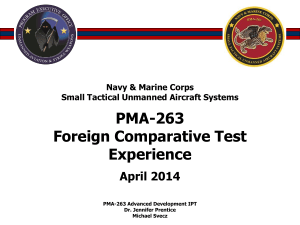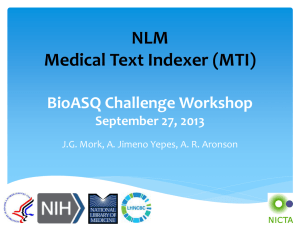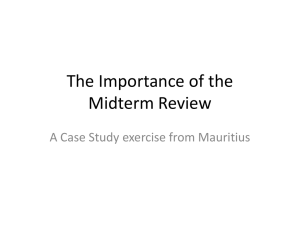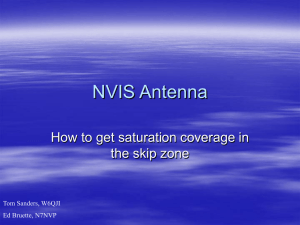Magnetization transfer Imaging Theory and Application
advertisement
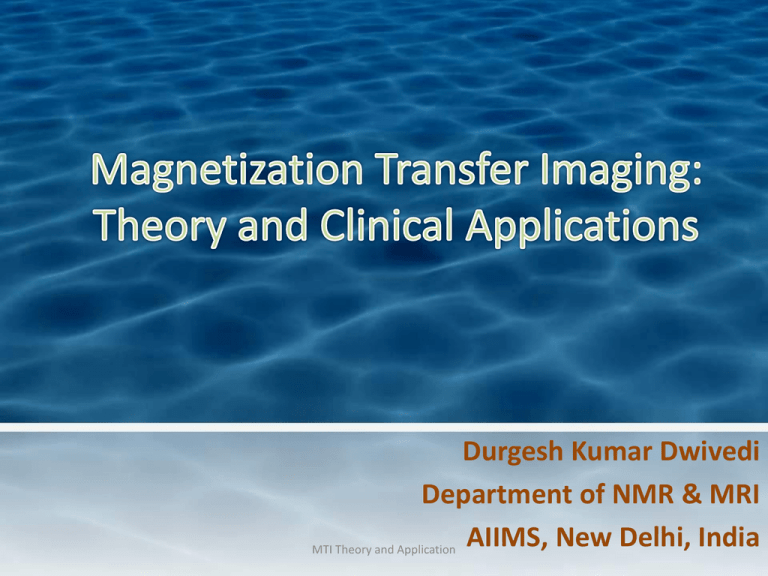
Durgesh Kumar Dwivedi Department of NMR & MRI AIIMS, New Delhi, India MTI Theory and Application Contents Magnetization Transfer (MT) T1 and T2 Relaxation in tissue The physical basis of magnetization transfer Attempts for quantification using MTR Theoretical approach of MTR & Pulse sequence Clinical Applications Conclusion MTI Theory and Application Fundamental Larmor Equation: ω= γ Bo MTI Theory and Application T1 relaxation A radio frequency (RF) pulse is applied (an oscillating electromagnetic wave) to the system at exactly the Larmor frequency of the precessing spin (‘on-resonance’). For hydrogen atoms this RF pulse has a frequency of 64 MHz for a magnetic field of 1.5 T. T1 is a characteristic of tissue and is defined as the time that it takes for the longitudinal magnetization to reach 63% of its final value MTI Theory and Application T2 relaxation T2 is the transverse relaxation time (or spin-spin relaxation time) and describes the disappearance of transverse magnetization Definition of T2 rel.: T2 is a characteristic of tissue and is defined as the time that it takes the transverse magnetization to decrease to 37% of its starting value. Bloch Equations The signal intensity (SI) in the case of a simple tissue, only reflecting T1 and T2 relaxation. N(1H) is the proton density (PD). Discovered accidentally : MT Magnetization transfer (MT) was first discovered accidentally by Wolff and Balaban (Wolff and Balaban 1989) They were trying to perform a spin transfer experiment by selective saturation of urea and were looking for a small signal suppression in water Instead they found a significant loss of image intensity This generalized signal suppression, now known as MT MTI Theory and Application Physical Basis of Magnetization Transfer Magnetization transfer (MT) imaging is an MRI technique that generates contrast dependent on the phenomenon of magnetization exchange between ‘free water’ protons and protons that are ‘restricted’ in macromolecules MTI Theory and Application MT- unique contrast MTI Theory and Application How MT works??? Proton MRI detects signal only from mobile protons which have sufficiently long T2 relaxation times (~10 ms) The T2 of the less mobile protons associated with macromolecules and membranes in biological tissues are too short (< 1 ms) to be detected directly in MRI Figure shows: Magnetization transfer between restricted protons (part of a macromolecule) and free protons in the surface layer Coupling between the macromolecular protons and the mobile or ‘liquid’ protons allows the spin state of the macromolecular protons to influence the spin state of the liquid protons through exchange MTI Theory and Application processes Concept of MT When an RF pulse is applied far enough off resonance, it will saturate the restricted protons without directly affecting the liquid protons The macromolecular spins have a much broader absorption lineshape than the liquid spins Making macromolecular spins as much as 106 times more sensitive to an appropriately placed offresonance irradiation. Fig: Absorption lineshapes of the free protons (liquid pool) and restricted protons (macromolecular pool). This preferential saturation of the macromolecular spins can be transferred to the liquid spins, depending on the rate of exchange between the two spin populations, and hence can be detected with MRI Continuous wave vs Pulsed wave MT Continuous wave (CW) saturation transfer techniques were the first used to demonstrate MT effects in tissue (Henkelman et al. 1993) Pulsed wave (PW) saturation techniques achieve selective saturation of the restricted proton resonance using either brief off-resonance RF pulses (applied at a frequency that is off-set from the free water resonance) or on-resonance (applied near the ‘free’ water resonance). (Sled et al. 2000) For practical imaging experiments, pulsed wave is preferred. Due to specific absorption rate (SAR) and RF transmitters MTI Theory and Application Specific Absorption Rate (SAR) Measures of the rate at which energy is absorbed by the body when exposed to a RF field. It is defined as the power absorbed per mass of tissue The radio frequency energy from an imaging sequence can cause heating of the tissues of the body The USFDA recommends that the exposure to RF energy be limited. SAR is the limiting measure [(SAR) = Joules of RF/second/kg of body weight = Watts/kg] The SAR for the whole body must be less than 0.4 W/kg . It must be less than 3.2 W/kg averaged over the head. All sequences are made according to guidelines MTI Theory and Application Two pool model: Theoretical approach Two-pool model of MT exchange. The shaded region in each pool represents saturated spins. RA & RB represent longitudinal relaxation rates (R=1/T) in liquid and macromolecule pools, respectively. R is MT exchange between the pools. A- Liquid pool, B- semisolid pool; M is no. of spins MTI Theory and Application Understanding: Two pool model In tissues, the number of macromolecular spins is much less than the liquid spins and the relative fraction is given by M0B Number of spins in “A” compartment (M0A) is by convention normalized to unity Unshaded portion: Longitudinal orientation Shaded portion: Saturated spins MTI Theory and Application Two pool model contd… The effect of off-resonance irradiation on this system is different for the two pools During off-resonance irradiation: Effe. saturation rate = [Prob. of absorption]at Δ * [Avg. RF power]at Δ Δ = offset frequency MTI Theory and Application Two pool model contd… In MT experiments, the intent is to manipulate the liquid pool indirectly by saturating the macromolecular pool During off-resonance: liquid pool like rotating frame of reference Beff = B1 + Δ/γ; where Δ = ωrf – ωo (~2kHz) MTI Theory and Application MT Theory contd… The most important process in MT is the exchange between the macromolecular pool and the liquid pool It is this exchange that transfers macromolecular saturation to the liquid pool, resulting in decreased longitudinal magnetization being available for imaging This spin exchange can occur via dipolar coupling or via direct chemical exchange MTI Theory and Application Pulse sequence The CW case gives a simplification of the Bloch equations. The magnetization as a function of the frequency offset is obtained In case of PW: during one period (TR) a Gaussian RF pulse, which is applied off-resonance, is followed by an excitation pulse (figure below), after which the signal is read out MTI Theory and Application Quantitative Imaging: MT & MTR Two main advantages over conventional MR: Provides morphological and pathological It enables us to asses “invisible lesion” burden in so called normal appearing white matter (NAWM) Quantitatively magnetization transfer ratio (MTR) is given by MTI Theory and Application MTR Image Generation Composition of an MTR image (FLASH3D) of an MS patient from a T1weighted image without (M0) and with MT pre-pulse (Ms). MTI Theory and Application Influence of different factors on MT Lack of uniformity of the MTR ratios. It can be assumed that the majority of variations in resulting MTR values is due to the degree of MT saturation experienced within a particular tissue region Certain features of the MR system that influence the degree of MT saturation are fixed, e.g. strength of the B0 field, coil hardware, prescan function; other features may be varied With respect to the B0 field, the influence of field inhomogeneities should be taken into account: shimming can decrease this problem The parameters that determine the MTR values can be classified in three groups: tissue properties, system parameters and data processing MTI Theory and Application Influence of different factors on MT Tissue properties: different tissues exhibit different degrees of magnetization transfer decreased MTR values may reflect demyelination or axonal loss; For off-resonance saturation transfer techniques, unwanted direct saturation effects play an important role, because off-resonance pulses also saturate the free pool directly System parameters: The amplitude, shape and duration of the MT saturation pulse and the interpulse interval determine the degree of saturation of both the free and restricted protons. Other factors: TR, TE, excitation flip angle, etc • MTR data processing: A shift of 1 mm or less due to patient motion may be enough to render invalid the calculated MTR value. At tissue interfaces (e.g. between grey and white matter, white matter and CSF, or lesion and adjacent unaffected tissue), MTI Theory and Application Experimental demonstration Fig. shows the same MT for 4% agar at a single B1 amplitude frequency of 0.67 kHz. The shaded region shows the amount of saturation coming from saturated agar spins exchanging with the water spins MTI Theory and Application Where Ksat: rate constant; T1SAT is the time constant for the two pools to come to equilibrium during irradiation Clinical application contd… Multiple sclerosis: Because of the demyelinating character of MS, MT imaging, which is sensitive to the presence of restricted protons, is a very useful method to monitor the destruction Normalized MTR for the whole brain of a healthy individual (dotted line) and a patient with MS (MS, solid line). The MS patient exhibits reduced peak MTR value and a lager proportion of brain pixels with low MTR values reflecting lesion In whole brain MTI Theory and Application Applications contd… Magnetic resonance angiography MR angio at 3T with MT suppression of brain tissue of 7-16% across image. MTI Theory and Application Applications contd… Optic neuritis Magnetization transfer image of a patient with right optic neuritis shows that the affected optic nerve has a dramatically lower MTR (20.1%) compared with that of the contralateral nerve (47.7%). This suggests structure loss of myelin as opposed to just edema. MTI Theory and Application Applications contd… Breast Cancer MTR: Benign Lesions: 19.02±3.40 Malignant Lesions: 14.77±2.19 at 1.5T BL (22.8 ± 4.2) and ML (19.9 ± 3.5) at 3T There are molecules secreted only by cancerous cells, Fibronectin, collagen type IV, and laminin are among the most frequent proteins related to stromal and cancer growth MTI Theory and Application Applications contd… Prostate cancer (A)T2-weighted image; (B) T2-weighted image showing the ROIs for the calculation MTR; (C) image without MT pulse; and (D) image with MT pulse. Cancer: MTR value (8.29±3.49) and controls: MTR was 6.18±1.63 MTI Theory and Application Conclusions & Future directions MT provides unique contrast MT has shown its value in MRA and white matter disease and holds continuing promise for use in imaging other tissues and diseases Could improve image specificity (MTR) Attention: field inhomogeneities, pulse sequence parameters, reproducibility etc. MTI Theory and Application Thank you MTI Theory and Application


